Hampi was the capital city of the
Vijayanagar Empire for almost two centuries (14-16th century) before
it fell to the combined armies of five Deccan sultanates. The city
was plundered for months and was finally abandoned to be consumed by
the wilderness. Centuries later, Hampi was discovered by English
archaeologists who unearthed stunning temples and sculptures. Today,
Hampi is declared as a UNESCO's World Heritage Site and attracts
thousands of visitors every year. Travellers to Hampi are struck by
the sheer grandeur and magnificence of the ruins, monuments and the
temples. The town is located around 350 km north of Bangalore and is
spread across more than 25 square kilometers. There are numerous
bus ticket booking services which allows you to book online bus tickets between the cities quickly and easily. Much of ruins
are concentrated along the road that connects Kamalapura to Hampi.
The Sacred Center is usually
where visitors begin their exploration of the town. The area is a
concentration of buildings that includes the famed Virupaksha Temple.
This functioning temple features an iconic complex with 9 tiered high
gopuram. Make sure not to miss the inverted image of the gopuram on a
stone wall created due to a pin-hole effect as the sun's rays pass
through a slit in the wall. Outside the complex lies the Hampi Bazaar
Street where you will find souvenir shops and a few restaurants.
South of the Sacred Center lies the
Royal Center which was the former site of the royal citadel of
the Vijayanagar kings. The monuments here are segregated as Royal
Enclosure, Zenana Enclosure (the women's complex), Danaik's Enclosure
and Nobleman's Quarter. The Zenana Enclosure depicts a Lotus Palace
designed with a blend of Islamic and Hindu architectural elements.
When exploring the area, keep an eye out for an underground Shiva
temple, the fallen stone doors, the uniquely designed Bhojanshala,
the circular granaries and the Hazara Rama Temple.
Next up is the Islamic Quarter which
served as the residential area for the muslim officers in
Vijayanagara army. The monuments here include the Talarigatta Gateway
and Ahmed Khan's mosque. The riverside Hampi Ruins lie on the
southern bank of the Tungabhadra and features an array of Shiv Ling
sculpted out of flat rocks and a few smaller temples.
If you have time to see only one
monument in Hampi, then make it the Vitthala Temple. The
temple complex comprises of an intricate set of gateways, mandapas
and shrines, all of which are contained in a massive fortress like
outer wall. On entering the eastern gate, you will see the iconic
stone chariot which has become synonymous with Hampi, thanks to its
portrayal in numerous tourism promotions.
The chariot might seems
like it was sculpted out of a single slab of stone but it is multiple
components that have been skillfully joined together to camouflage
the joints. The four stone wheels are mobile and they appear to have
been drawn by a pair of elephants. In front of the chariot lies the
maha-mandapa of the primary temple. The pillars of the mandapa
produce musical notes when tapped but its now prohibited in order to
reduce damage to the monument.





